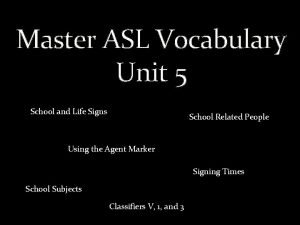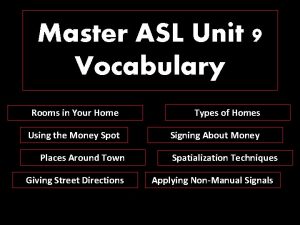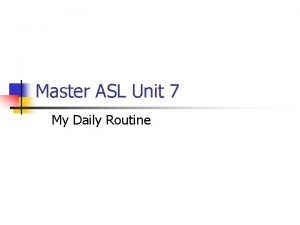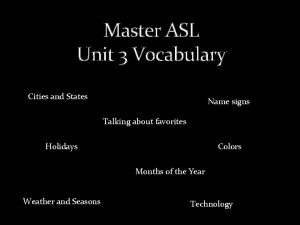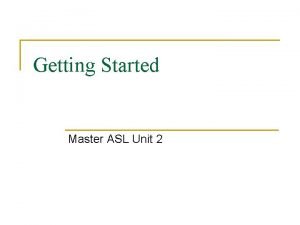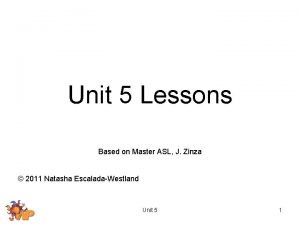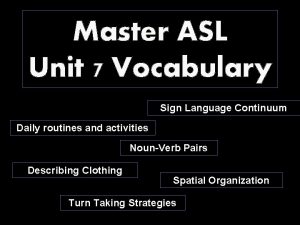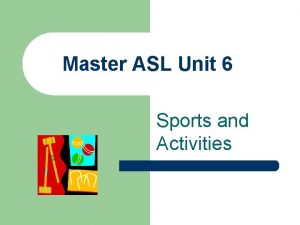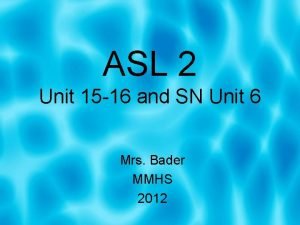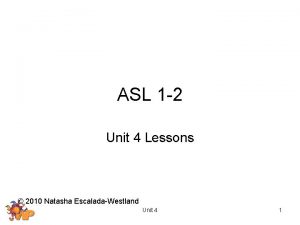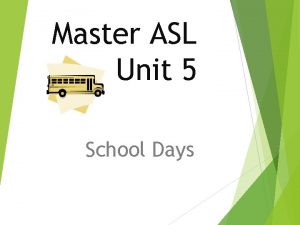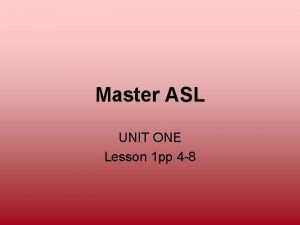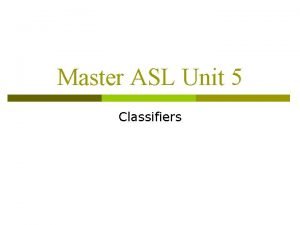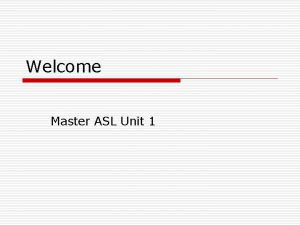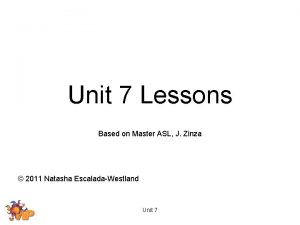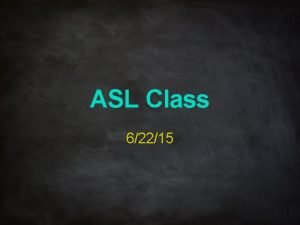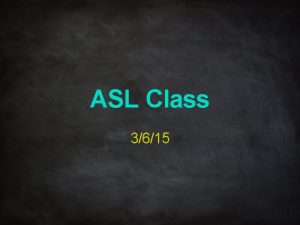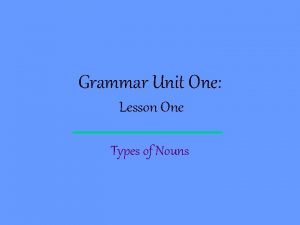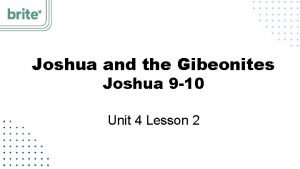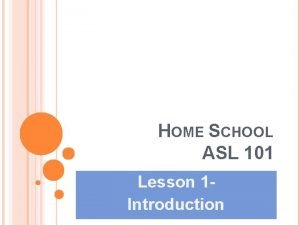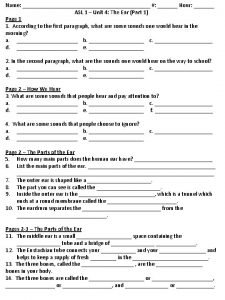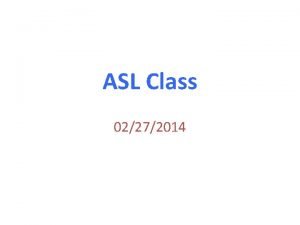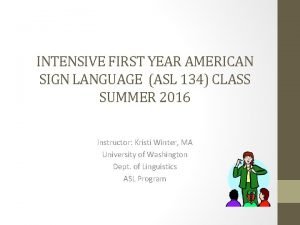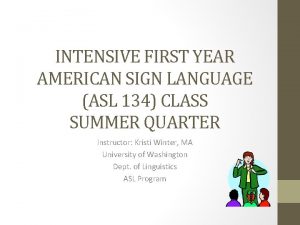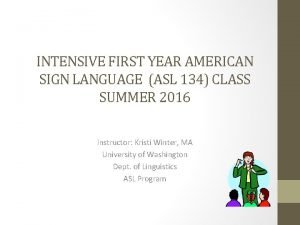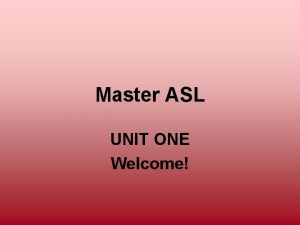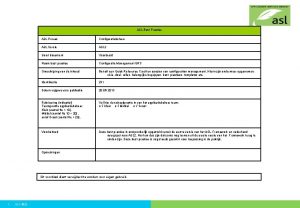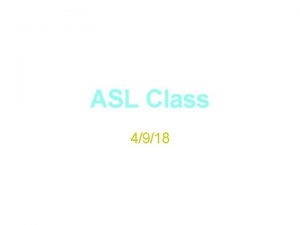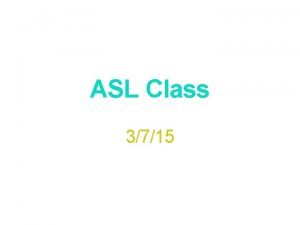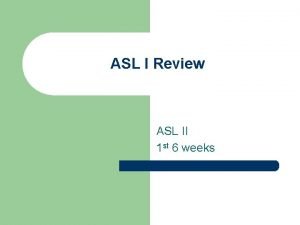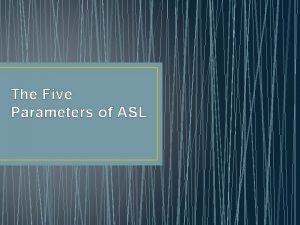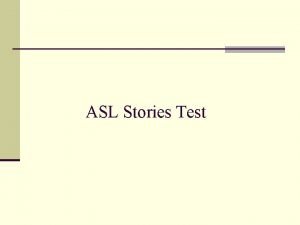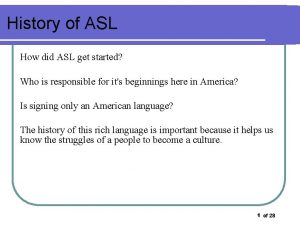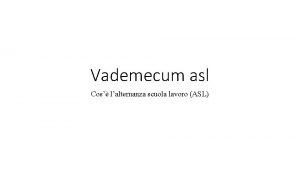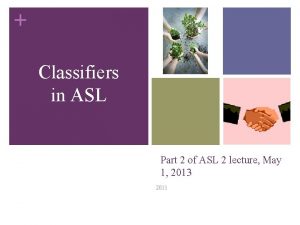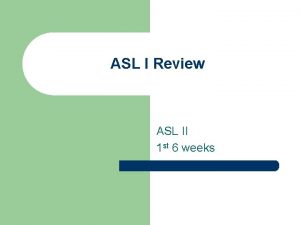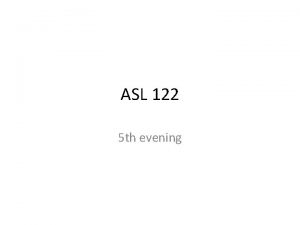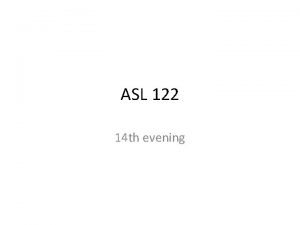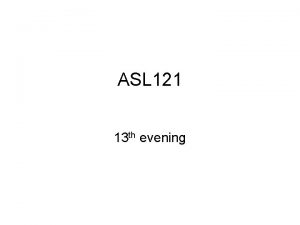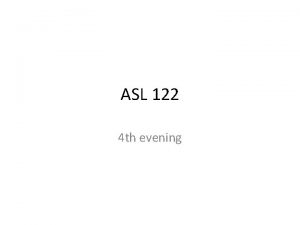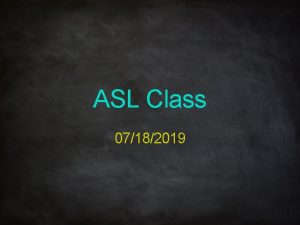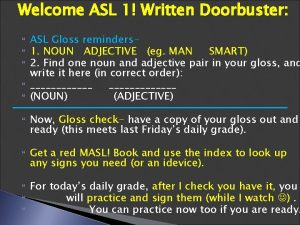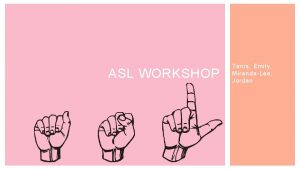Master ASL UNIT ONE Lesson 1 pp 4
















































- Slides: 48

Master ASL UNIT ONE Lesson 1 pp 4 -8

Lesson One pp 4 -8 Outcomes: Can exchange and respond to formal and informal greetings Demonstrate a variety of responses about one’s state of being Uses deixis with eye gaze • Greetings • Formal vs informal • Eyes on ASL #1 *Eye contact • Deixis w eye gaze Homework Ex 1 pg 8 Objective: Can explain how to introduce oneself in the culturally appropriate manner

Formal or Informal FORMAL INFORMAL Signing to adults, people you don’t know well. Signing to friends and peers Use: HELLO HOW-ARE-YOU? Use: HI WHAT’S-UP?

Formal or Informal • When signing to friends sign Hi! • When signing with adults or people you don’t know well, use the more formal Hello. • What’s-up? is an informal way to ask How-areyou? • How-are-you? Is formal in both English and in ASL. Note: you can sign What’s-up? one-handed, but both signs must include raising your chin. p 4

ASL Up Close Deixis Pointing is a logical feature of a signed, non spoken language. It is not considered rude or impolite. If a person or object is not visible, point to an empty space and continue signing. Using the index finger to point is called deixis. Conjugating Verbs: To Be I, I am, me, You, you are, He, she, it is, We, we are, us You, you are (plural) They, they are, MASL p 6

Vocabulary More Greetings • Good+afternoon • Good+evening/night • Good+morning “American Sign Language is of great value to the deaf, but could also be of great benefit to the hearing as well… It is superior to spoken language in its beauty and emotional expressiveness. It brings kindred souls into a much more close and conscious communion than mere speech can possibly do. ” –Thomas H. Gallaudet 1848

Eyes on ASL #1 Eye contact DVD Eye contact is very important in ASL. Watch the DVD clip about eye contact What is the purpose of eye contact? It shows respect. Not having eye contact shows: boredom or disinterest. Keeping eye contact shows – that you are participating. Eye contact shows that you are listening.

Eyes on ASL #1 Eye contact DVD Eye contact shows that you are listening. Breaking eye-contact can be compared to Covering your ears to block out what someone is saying to you. If you break eye contact you disrupt the communication. Maintaining eye contact does not mean staring. If you must look away, make the hold on sign first.

Eyes on ASL #2 MASL DVD There is no such thing as a one-word answer or reply in American Sign Language. When responding to a question or statement, one-word replies are incomplete.

Lesson Two Outcomes: Asks for and provides first and last name in a culturally appropriate manner. Can fingerspell first and last name clearly Uses the closing signal at the end of sentences Responds to questions in a complete sentence Can fingerspell the ASL alphabet • • • Closing signals Names Fingerspelling Eyes on ASL 2 *Closing Signals Eyes on ASL 3 *One word answers. MASL pp 9 -10

I Want to Know… Why do I have to point twice? • Pointing back to yourself or the person you’re talking about shows completion of a train of thought • This allows somebody else to begin signing without interrupting you. • Using deixis at the end of a sentence is called closing signal. • Closing signals are especially important when asking questions using the question maker(p. 15)or the WH face (p 42). Remember to use closing signals when: • Making a statement or comment about yourself or somebody else. • Asking a question. MASL p 9

Eyes on ASL #2 MASL DVD • Always use a closing signal to complete a signed sentence. • ASL sentences lacking closing signals are incomplete.

Deaf Culture Minute Introductions in the Deaf community tend to include both first and last names. Often, new acquaintances know relatives or have friends in common. Many Deaf people have stories about meeting a friend of a friend in other cities, states, and even countries! How is this similar or different from our own community? MASL p 10

Lesson Three Outcomes: Can introduce oneself and mention hearing status Can introduce two individuals by name and mention hearing status • Introducing oneself • Hearing status • Making introductions MASL pp 11 -13

Introductions I WANT INTRODUCE MY FRIEND I want to introduce my friend. SHE NAME L-I-S-A SHE Her name is Lisa. Introductions in the Deaf community vary depending on whether one is hearing or Deaf. If you are Deaf, background information like where one goes or went to school is exchanged. If you are hearing, then you will be introduced as a hearing person who knows or is learning American Sign Language. This information allows everybody to understand where he or she is coming from and reduces cultural misunderstandings. It is culturally appropriate to shake hands when meeting new people or greeting friends. Like many hearing people, Deaf friends often hug each other when saying hello and good-bye. MASL p 11

Accent Steps When fingerspelling your complete name, you don’t need to sign “last name” between the first and last name. Just pause briefly and continue on! FYI Use deixis instead of the sign my when signing “My name is…” MASL p 12

Lesson Four Outcomes: Understands behavioral expectations within the Deaf community regarding attentiongetting strategies and use of voice. • Interacting with Deaf people MASL pp 14

Deaf Culture MASL DVD E T O N Interacting with Deaf People As a student of American Sign Language, learn how to interact with the Deaf Community by becoming familiar with Deaf culture behaviors that differ from the way you are used to doing things as a hearing person. One cultural behavior you’ve already learned is that it is considered rude to break eye contact when signing with Deaf people, which for most hearing people is often difficult. Think of how often you turn your head in the direction of sound and you can realize it will be a challenge to break this habit! Lesson 4 MASL p 14

Deaf Culture E T O N GETTING ATTENTION Getting attention of a Deaf person is different from the way you interact with hearing people. Many hearing people tend to work harder than necessary to gain a Deaf individual’s attention by wildly swinging their hands in the air, stomping on the floor, or flashing overhead lights in a strobe pattern. None of this is necessary! Gently tapping the Deaf person’s shoulder or slightly waving a hand in his or her direction until you are noticed is the most effective and considerate way to get attention. Lesson 4 MASL p 14

Deaf Culture E T O N VOICES Using your voice to talk to another hearing individual instead of signing when a Deaf person is near is considered rude. Develop the habit of always signing when you know a Deaf person is in the same room with you. This way everybody has equal access to what is being communicated. If you must speak to a hearing person who doesn’t know ASL, then tell your Deaf friend or teacher that first, before speaking. You may be surprised to learn that most Deaf people know when hearing people talking, even if someone is whispering. How so? Remember, Deaf people rely on their vision far more than hearing people do! Your teacher may remind you to turn off voice if you’re being rude in class. Lesson 4 MASL p 14

Lesson Five MASL pp 15 -18 Outcomes: Uses the Question-Marker non-manual signal to ask simple yes/no questions Understands differences between questions and statements Demonstrates receptive and expressive understanding of ASL numbers 1 -10, Including palm orientation for numbers 1 -5 • The Question Maker • Numbers 1 - 10

ASL Up Close MASL DVD The Question-Maker Raising our eyebrows forms the Question-Maker, an expression that shows you are asking a question. Keep the eyebrows raised until you’ve completed signing the question. In the example, notice the only difference between a question and a comment is the facial expression. The signs themselves remain the same. BATHROOM • I am going to the bathroom. • Am I going to the bathroom? LOOK AT THE ILLUSTRATIONS ON P 15 TO SEE THE DIFFERENCE. MASL p 15

Classroom Exercise 2. I Responses. Use the signs yes or no in response to the same questions in Part 1. Example: NO, I DEAF I. 1. HARD of HEARING 2. MEET 3. HEARING 4. DEAF Vocabulary THEY MEET HEARING HARD OF HEARING FYI Slowly shake your head during sentences beginning with no. MASL p 15

Accent Steps When you use deixis, look towards the area you’re pointing to. This is called eye gaze and helps “hold” that location for the person or thing you’re signing about. MASL p 17

Classroom Exercise L OBJECTIVE: ANSWER IN COMPLETE SENTENCES 1 Asking questions Use the Question-Maker face to ask a partner several questions. Be sure to respond in a complete sentence, including a closing signal. When finished, switch roles and repeat the exercise. Example: Are you learning to sign? Yes, I’m learning to sign. or Yes, I’m learning sign language. 1. 2. 3. 4. 5. Are you learning sign language? Are you hearing? Do you want to learn ASL? Do you want to meet my friend? Good morning. How are you? FYI a widespread pet peeve in the Deaf community is someone who says death instead of Deaf, especially when they ask “Are you Death? ” MASL p 18

Lesson Six MASL pp 19 -21 Outcomes: Can express farewells in a variety of forms Adopts the cultural model of mentioning the next time individuals will see each other again • • Farewells Making plans to meet again

Signing Goodbye The sign goodbye is a well-known way to say farewell. Signing take-care is an informal way to say goodbye. Often, goodbyes are never complete until plans are made for the next time friends will see each other again. Shaking hands and hugging is common. It is considered rude to leave a group of Deaf friends without saying goodbye to each person, which means farewells can take a long time! Is this similar to how hearing people leave groups of friend? MASL p 19

Good-bye Watch marc and Kris sign farewells. Kris -I’m happy to have met you. Marc -Me too! I’ll see you tomorrow. Kris - Yes, tomorrow morning. Take care! Marc - Goodbye! ACCENT STEPS Don’tdon’t You add need the separate a separate sign for you for don’t or not. signing when Just use see-you-later the head shake or see-youwhile signing the sentence tomorrow MASL p 19

Lesson Seven MASL pp 22 -24 Outcomes: Understands ASL was forbidden at school for the Deaf and gradually gained acceptance in the 1960’s and 1970’s gains exposure to several learning strategies Understands ASL and English are distinct and separate languages Practice analyzing the root concepts of English words to determine similar or different ASL concepts

Focus: How do people learn The majority of Deaf people are raised in families where deafness is not common. Approximately 10 percent of Deaf people have Deaf parents and grow up in families where American Sign Language is used daily. When these two populations came together at schools for the Deaf, those who did not know sign language, learned from the Deaf children with Deaf parents. Often the use of sign language was forbidden at schools for the deaf but the desire for a natural, visual language could not be suppressed. Many Deaf people can share stories of only being allowed to sign when class was not in session. Hearing people who learned ASL tended to be children of deaf adults or individuals who worked with the deaf. http: //yourlifetimelegacy. com/07 -deaf-children. html MASL P 22

Focus: D P N • • • In the 1960’s, ASL gained recognition as a unique language different form English, In the 1970’s school for the Deaf began using ASL to teach their students and sign language classes for hearing people mushroomed across the United States. By the 1980’s the Deaf community was considered a cultural minority rather than a group of disabled persons. An important change based largely on the successful Deaf President Now movement at Gallaudet University, the world’s only university for the Deaf. At the same time, Deaf accomplishments in the arts, film, and television brought wider exposure to the Deaf community. By the 1990’s American Sign Language became the fastest growing language offered as a foreign language, a trend that continues today. MASL P 22

Focus: I-L-Y • The best way to learn any language, including ASL, is to immerse yourself in the community where the language is used. • Make Deaf friends and attend Deaf sporting, theatrical, and social events when invited. • You will quickly realize there is a different “Deaf World” to learn about and participate in, provided you make the effort to sign. • As a student learning ASL, it is up to you to learn the language and culture of the Deaf community. • You can do this by being open-minded, practicing, and taking an interest in the Deaf community. MASL P 22

Focus: American Sign Language? As a student studying American Sign Language, the following principles will help prepare you to learn this challenging visual language. The most fundamental and essential point is to recognize and accept that American Sign Language is not English. ASL has its own grammar, structure, and nuances that are designed for the eye, not for the ear, unlike spoken languages. Remember that ASL makes visual sense and was developed to serve the language needs of a community of people who do not hear, Other considerations to keep in mind: MASL P 22

Focus: Which Sign? § One word in English can have many separate signs in ASL, depending on the concept. § For example, the word “get” and “got” in the following sentences each uses a different sign. 1. Please get the book… 2. Please get him… 3. I don’t get it…. 4. I get tired… 5. I got home. . 6. I’ve got it… Look at MASL p 23. There are pictures of six different signs. – Can you figure out which sign matches each sentence? MASL P 22

Focus: Visualize the Concept § Though it’s a challenge, try not to translate word for word or sign by sign. Try to visualize the concept instead. Likewise, don’t worry about not knowing specific signs for the particular English phrase you have in mind; try to communicate by concept by pointing, miming, and using other signs you know rather than fingerspelling the unknown term. § Don’t fall into the habit of “talking silently” or whispering while you sign. You will learn how ASL uses the lips as part of its grammar. Some students rely on lipreading rather than signing skills, a sure way to become frustrated since most of the English language cannot be lipread! Using ASL sign while talking or “mouthing” English is not ASL. MASL P 23

Focus on the Face As a beginner signer, you will want to keep your eyes on the hands of the person who is signing. With exposure and practice you will learn to watch the signer’s hands, face and eyes nearly simultaneously. ASL is not only comprised of signs but also includes specific mouth movements and head shakes and nods. Eye contact informs the signer that you are paying attention. Practice ASL and make Deaf friends and acquaintances in your community. Before long you’ll be given the compliment, “You sign like a Deaf person!” MASL P 23

I Want to Know… Where all the “little” words like is, to, and are? This question is often asked by beginning American Sign Language students. It is part of a much bigger question: Is ASL like English, except that it’s signed instead of spoken? The answer is no, not at all. Just as Japanese, Spanish, and Latin are not English, neither is ASL. All languages have different ways of putting words together into correct sentences. If you translate an English sentence word for word into any other language, or use ASL signs in English word order, the results don’t make sense. The grammar and syntax (the order in which words are put together) of ASL is different than English. ASL does not need separate “little” words because these words are already included in each sign. MASL p 24

I Want to Know… cont. For example, look at the sign thank you. Even though English requires two words to make sense (the verb “to thank” and the object “you”), ASL uses one sign that incorporates both the verb and the object. How so? Where does the thank you sign point toward? The object or you. Still unsure? What would happen if you added the sign you to thank you? It would “look funny” and make as much sense in ASL as saying “thank you” does in English! MASL p 24

I Want to Know… cont. Take a look at the ASL sentence below. See pics MASL p 24 Its English translation is “my name is Kelly. ” The sentence can be broken down and analyzed sign by sign: I-AM NAMED K-E-L-L-Y Deixis conveys the verb “to be” whether it’s a person or thing: I am, you are, it is, we are, they are. MASL p 24

Respect the Language Because ASL is a “real” and separate language different from English, it is important that you learn how to use the language properly. This means respecting the language for how it is structured, instead of wondering why it isn’t like you own spoken language! MASL p 24

ASL Up Close Facial Expressions & Non-Manual Signals One noticeable difference between ASL and English is the use of facial expressions and Non manual signals. Non-manual signals (abbreviated NMS) are the various parts to a sign that are not signed on the hands. For example, ASL adverbs are made by the eyes and eyebrows, and ASL adjectives use the mouth, tongue, and lips. One important group of NMS are facial expressions, which convey your tone of “voice” while signing. Your facial expressions should match the meaning and content of what you’re signing so if you’re signing I am happy, then look happy! See example p 25 • Why doesn’t the example make sense? • How can you make the sentence clearer? MASL p 25

ASL Up Close • Changing a facial expression modifies the meaning of the sign, even if the sign itself doesn’t change. Think of facial expressions as occupying positions on a scale, like the one shown below (p 25). Unlike English which uses separate words to describe related meanings, ASL uses related facial expressions with the base meaning of a sign. ___________________________ no meaning not scared at all scared very scared terrified

Using Non-Manual Signals Turn to page 28 in your MASL book to view illustrations You have already begun using two important non-manual signals when you sign yes or no. These signs must be paired with two NMS called the head nod and the head shake. Use these non-manual signals when using yes or no or when you affirm or negate sentences. Gently nod or shake your head when signing your sentence instead of wildly exaggerating your head movements. Look at the examples to see how these NMS are used in ASL sentences. MASL p 28

Classroom Exercise S Deaf, hearing, yes, learning, sign, go-to, bathroom, they, sick, we, busy NMS Use the correct NMS while signing each sentence. 1. I’m not Deaf. I’m hearing. 2. Yes, I’m learning how to sign. 3. I didn’t go to the bathroom. 4. They aren’t sick. 5. We’re not busy. ACCENT STEPS You don’t need a separate sign for don’t or not. Just use the head shake while signing the sentence MASL p 28

Vocabulary • • Absent I don’t mind Due, owe Favorite Movie Practice School Today, now Conversation FYI Practice also means exercise as in “Exercise U” MASL p 30

Classroom Exercise U Using NMS. Sign the phrase or sentence using the correct NMS. Eyes on ASL # 4 When signing yes, nod your head; when signing no, shake your head. Combining a sign and head shake negates the meaning from positive to negative. 1. I’m not absent. 2. Not today. 3. The homework isn’t due. 4. I don’t mind. 5. We don’t understand. 6. They don’t like the movie. MASL p 30

Accent Steps If you use the question-maker with I don’t mind then it becomes a question Do you mind? MASL p 32

Deaf Culture Minute The best way to learn any language is to socialize with the people who use it. Go out and meet Deaf people in your local community. As you make friends and practice, you’ll see your signing skills improve quickly! MASL p 32
 Master asl unit 5
Master asl unit 5 Master asl unit 9 pdf
Master asl unit 9 pdf Master asl unit 7 pdf
Master asl unit 7 pdf Unit 3 comprehension test asl
Unit 3 comprehension test asl Master asl unit 2 pdf answers
Master asl unit 2 pdf answers Master asl unit 5
Master asl unit 5 Master asl unit 2 pdf answers
Master asl unit 2 pdf answers Master asl unit 7
Master asl unit 7 Sports in asl
Sports in asl Asl unit 2 comprehension test
Asl unit 2 comprehension test Unit 4 story comprehension asl
Unit 4 story comprehension asl Soda machine in asl
Soda machine in asl Asl lesson 1
Asl lesson 1 What are classifiers in asl
What are classifiers in asl Deaf awareness quiz
Deaf awareness quiz Spatial organization asl
Spatial organization asl Asl family portrait
Asl family portrait Ghost in my room asl answers
Ghost in my room asl answers Unit one lesson one
Unit one lesson one Unit one lesson
Unit one lesson One god one empire one religion
One god one empire one religion One one one little dog run
One one one little dog run One king one law one faith
One king one law one faith One empire one god one emperor
One empire one god one emperor One ford
One ford See one do one teach one
See one do one teach one One price policy
One price policy Willow cabin speech
Willow cabin speech See one do one teach one
See one do one teach one Asean tourism strategic plan
Asean tourism strategic plan Graphic organizer with the aims of la liga filipina
Graphic organizer with the aims of la liga filipina Unit 8 lesson 5 joshua's law
Unit 8 lesson 5 joshua's law Hyp opp adj triangle
Hyp opp adj triangle Unit 6 review questions
Unit 6 review questions Asl lesson 1
Asl lesson 1 Asl bill vicars lesson 1
Asl bill vicars lesson 1 Asl 1 hour
Asl 1 hour Unit 4 story comprehension asl
Unit 4 story comprehension asl Signing naturally unit 5 answer key
Signing naturally unit 5 answer key Signing naturally 5:5
Signing naturally 5:5 Signing naturally 5:8 answers
Signing naturally 5:8 answers Language background
Language background How to sign chores in asl
How to sign chores in asl Lesson outline lesson 3 describing circuits answers
Lesson outline lesson 3 describing circuits answers Kind of fault
Kind of fault Lesson outline lesson 2 aquatic ecosystems answer key
Lesson outline lesson 2 aquatic ecosystems answer key Micro-lesson
Micro-lesson Ihi l101
Ihi l101 Learning outcomes of a gift of chappals
Learning outcomes of a gift of chappals
